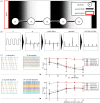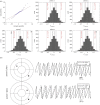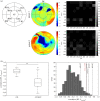Information theory-based direct causality measure to assess cardiac fibrillation dynamics
- PMID: 37817583
- PMCID: PMC10565370
- DOI: 10.1098/rsif.2023.0443
Information theory-based direct causality measure to assess cardiac fibrillation dynamics
Abstract
Understanding the mechanism sustaining cardiac fibrillation can facilitate the personalization of treatment. Granger causality analysis can be used to determine the existence of a hierarchical fibrillation mechanism that is more amenable to ablation treatment in cardiac time-series data. Conventional Granger causality based on linear predictability may fail if the assumption is not met or given sparsely sampled, high-dimensional data. More recently developed information theory-based causality measures could potentially provide a more accurate estimate of the nonlinear coupling. However, despite their successful application to linear and nonlinear physical systems, their use is not known in the clinical field. Partial mutual information from mixed embedding (PMIME) was implemented to identify the direct coupling of cardiac electrophysiology signals. We show that PMIME requires less data and is more robust to extrinsic confounding factors. The algorithms were then extended for efficient characterization of fibrillation organization and hierarchy using clinical high-dimensional data. We show that PMIME network measures correlate well with the spatio-temporal organization of fibrillation and demonstrated that hierarchical type of fibrillation and drivers could be identified in a subset of ventricular fibrillation patients, such that regions of high hierarchy are associated with high dominant frequency.
Keywords: Granger causality; complexity; fibrillation; information theory.
Conflict of interest statement
B.H., X.L., F.S.N. and N.P. are applicants for a patent to Granger Causality Fibrillation Mapping (UK Patent Application no. 1903259.8).
Figures






References
-
- Kuck KH, et al. 2016. Cryoballoon or radiofrequency ablation for paroxysmal atrial fibrillation. J. Cardiopulm. Rehabil. Prev. 36, 393-394. ( 10.1056/NEJMoa1602014) - DOI
Publication types
MeSH terms
Grants and funding
LinkOut - more resources
Full Text Sources
Miscellaneous

